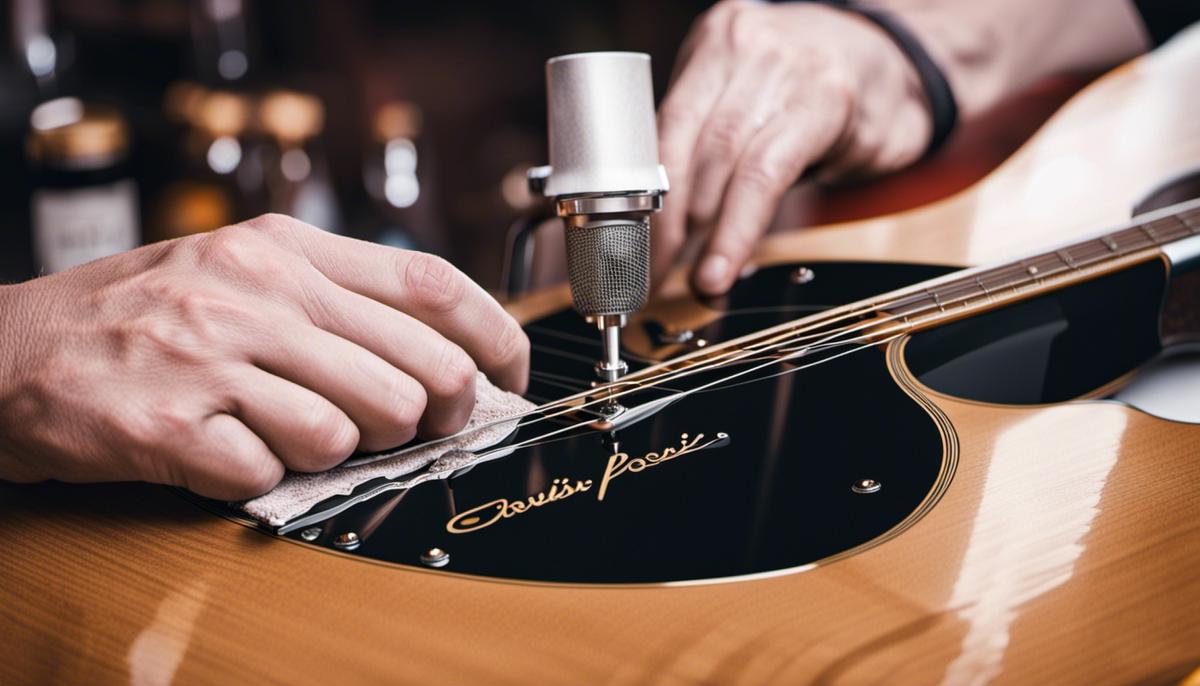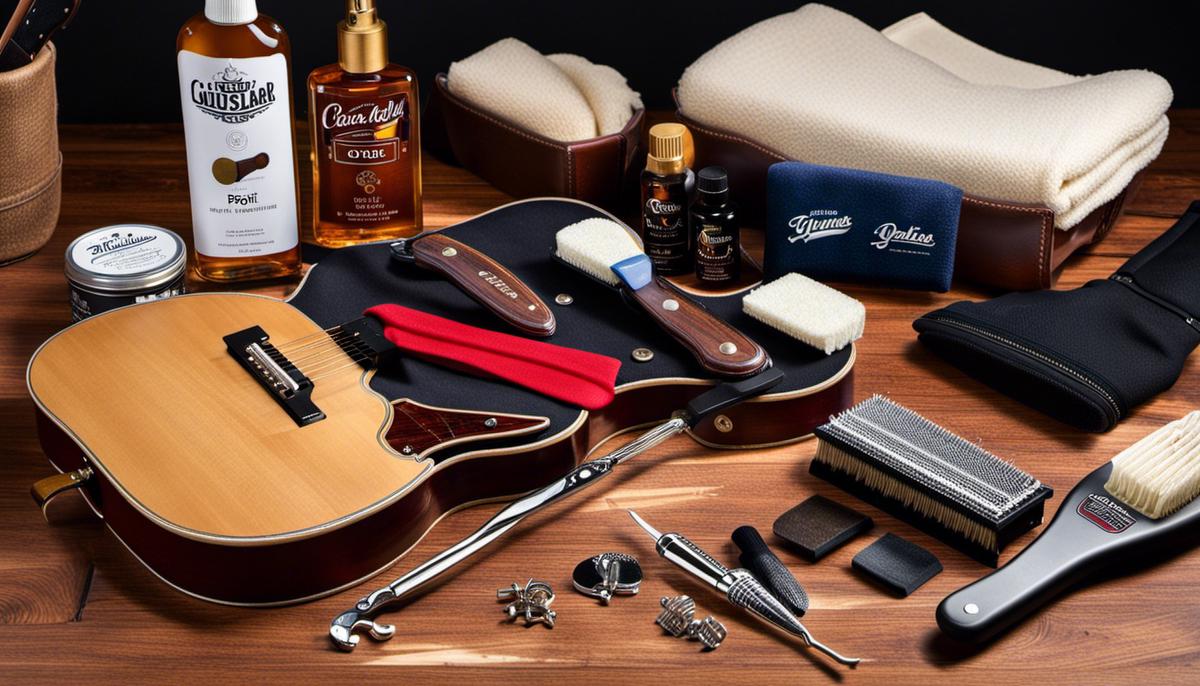
As any guitar enthusiast will attest, maintaining your instrument is as vital as learning the correct chords and mastering strumming techniques. Just as a car needs regular check-ups and oil changes, your guitar requires care and attention to remain in excellent playing condition. This care extends from the guitar’s body to its fretboard, creating an integral part of its lifespan and sound quality. With regular cleaning and polishing, proper string maintenance, and insightful knowledge on accurate setup and adjustments, you’ll enhance the functional longevity of your guitar and maintain its immaculate sound quality.
Cleaning and Polishing
Understanding the Basics of Guitar Maintenance
In preserving the overall sound and lifespan of your guitar, regular maintenance should be a priority. A crucial part of this maintenance involves proper cleaning and polishing. Different parts of your guitar, such as the body, neck, and fretboard, require different cleaning techniques and solutions.
Cleaning the Body of Your Guitar
The body of your guitar often accumulates grime, dust, and sweat. To clean it, first remove the strings to easily access the entire body. Use a specially designed guitar polish and a soft cloth to gently wipe the body. Avoid using furniture polish or other cleaning products as they could damage your guitar’s finish. Follow the grain of the wood when cleaning and polishing to prevent scratches.
Taking Care of the Neck and Fretboard
The neck and fretboard need special attention, as dirt and sweat can build up in the small spaces between the frets. Use a dry, clean toothbrush or a small paintbrush to gently sweep away grime from these areas. For a deeper clean, use a slightly damped cloth and a little lemon oil or specialized guitar cleaner. Make sure to dry the neck and fretboard thoroughly after cleaning.
Polishing your Guitar
Polishing your guitar can add a shine and protective layer to its finish. Apply a small amount of guitar polish on a clean cloth. Gently rub the polish onto the body and neck of the guitar following the direction of the grain. Make sure to use a circular motion that contributes to an even shine.
Re-stringing your Guitar
After cleaning and polishing, replace the strings on your guitar. This process can also help in maintaining your instrument’s sound quality as old strings can impact tonality.
Remember, when it comes to guitar maintenance, consistency is key. Make cleaning and polishing a regular part of your guitar care routine. With proper and regular maintenance, you can prolong the life of your guitar and keep it sounding its best.

String Maintenance
Knowing when to Change the Guitar Strings
The first step in maintaining a guitar is knowing when to change the strings. As a rule of thumb, guitarists often replace their strings about once every three months or 100 playing hours, but this can vary greatly depending on how often you play, your playing style, and the atmosphere in which your guitar is stored. Strings decay with time and use, causing the quality of your sound to decrease. Signs that your strings may need to be changed include a dull or flat sound, difficulty tuning, string discoloration, rust, or visible indentations from pressing against the frets.
Procedure for Changing Guitar Strings
When changing your guitar strings, start by loosening the string tension with the tuning pegs. Once the string is loose, remove it from the peg, then from the bridge at the base of the guitar. Repeat this process with the next string. It’s best to replace all strings at once to maintain consistent sound quality.
With the new string at hand, thread one end through the hole in the tuning peg, then down to the bridge. Many guitars have a different process for attaching the string to the bridge, so it might be best to refer to the manufacturer’s guide for your specific guitar model. Once the string is securely fastened, tighten it with the tuning peg until it reaches the appropriate pitch.
Properly Tuning your Guitar
Consistent tuning is an essential part of guitar maintenance. An electronic tuner is the easiest way to tune your guitar, especially for beginners. Pluck one string at a time, starting with the lowest (the thickest) string. Your tuner will tell you if the string’s pitch is too low (flat) or too high (sharp). Adjust the string’s tightness using the tuning peg until the tuner indicates that the string is in tune. Repeat this process for each string.
Maintaining String Hygiene
To prolong the life of your strings, maintain good string hygiene. Cleaning the strings each time after you play can reduce corrosion and finger grime buildup. Simply use a dry microfiber cloth to wipe down the strings from top to bottom. You can also use a string cleaner or conditioner for a deeper clean. Avoid using household cleaners, as they can damage the strings.
Additionally, washing your hands before playing can also help keep your guitar strings clean. This practice reduces the amount of oils and dirt that transfer from your fingers to the fretboard and strings. Quick routine wire wipes after playing and prior proper hand cleanliness can do wonders towards preserving your strings and ultimately the quality of your guitar sound.
By observing these basic maintenance routines, you will significantly enhance your instrument’s lifespan and the quality of your guitar’s sound.

Guitar Setup and Adjustments
Adjusting the Truss Rod
The truss rod is a thin, steel rod that runs along the neck of the guitar. It counteracts the tension caused by the guitar’s strings, preventing the neck from bending or warping over time. To make adjustments, you will need a truss rod wrench. Before adjusting, it’s crucial to note the straightness or bow of the neck.
Rotate the truss rod to the right or clockwise to straighten the neck if the string’s height from the frets is uneven, it generally means your truss rod needs to be tightened. On the contrary, if the strings are too high from the middle frets, the neck has a back bow and the truss rod must be loosened by turning counter-clockwise. Remember, do not force the truss rod if it doesn’t easily turn and make small adjustments each time, rechecking after every quarter turn.
Adjusting the Saddle Height
The saddle height refers to the action of the guitar, or how high the strings sit off the fretboard. This adjustment impacts playability and the strings’ pitch. To adjust the saddle height, you will typically need a small Phillips-head or flat-head screwdriver, depending on your guitar model.
To raise the action, loosen the screws on the saddle, raising the saddle and providing more distance from the strings to the fretboard. Conversely, to lower the action, tighten the screws, pulling the saddle down and reducing the distance to the fretboard. After adjusting, test the playability, and note whether any frets buzz when you play the guitar.
Adjusting the Intonation
Intonation refers to a guitar’s ability to stay in tune across the entire fretboard. Poor intonation can lead to notes sounding out of tune as you move up the fretboard. To adjust your guitar’s intonation, you’ll need an electronic tuner.
Start tuning your guitar from the 12th fret. If the 12th fret harmonic (an “open” note played by lightly touching the string at the 12th fret and plucking it) matches the fretted note at the 12th fret, your intonation is correct. If the fretted note is sharp (higher in pitch), increase the length of the string by moving the saddle backward. If the note is flat (lower in pitch), decrease the string length by moving the saddle forward. Always re-tune your guitar to the open string after making an adjustment. Repeat the process until both notes match.
Remember to take your time with these adjustments. Mistakes can potentially damage your guitar or affect its playability. If you are uncomfortable performing these tasks, consider bringing your guitar to a professional for setup and adjustments.

Proper guitar maintenance isn’t just about preservation. It’s about creating a harmonious relationship with your instrument. Through understanding and implementing the necessary care techniques, you can ensure that your guitar produces the sounds it was designed to yield, from the lively plucks to the soulful strums. There is infinite satisfaction and pride to be found in maintaining your guitar at its finest. So practice your chords, fine-tune your strings, and don’t forget to clean your guitar, embracing its exceptional sound and beautiful form.
Comments are closed.